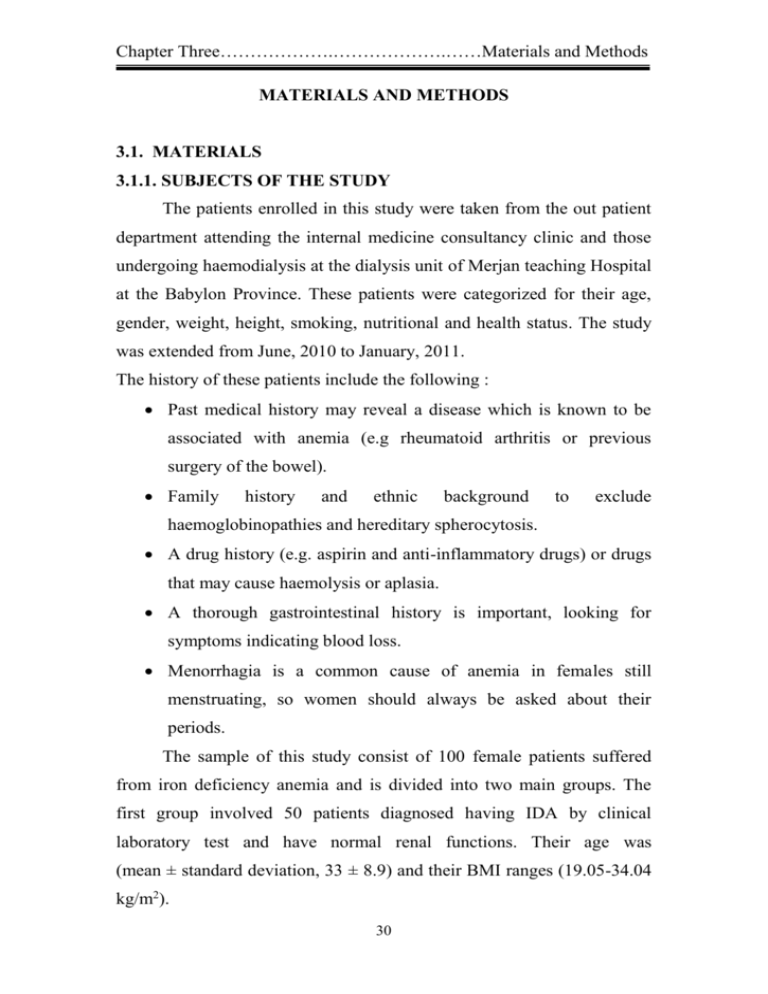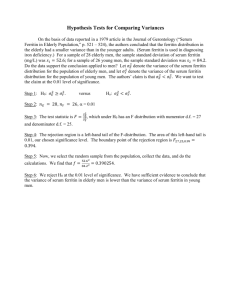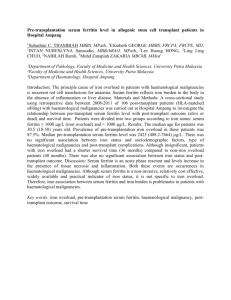kit enzyme
advertisement

Chapter Three……………….……………….……Materials and Methods MATERIALS AND METHODS 3.1. MATERIALS 3.1.1. SUBJECTS OF THE STUDY The patients enrolled in this study were taken from the out patient department attending the internal medicine consultancy clinic and those undergoing haemodialysis at the dialysis unit of Merjan teaching Hospital at the Babylon Province. These patients were categorized for their age, gender, weight, height, smoking, nutritional and health status. The study was extended from June, 2010 to January, 2011. The history of these patients include the following : Past medical history may reveal a disease which is known to be associated with anemia (e.g rheumatoid arthritis or previous surgery of the bowel). Family history and ethnic background to exclude haemoglobinopathies and hereditary spherocytosis. A drug history (e.g. aspirin and anti-inflammatory drugs) or drugs that may cause haemolysis or aplasia. A thorough gastrointestinal history is important, looking for symptoms indicating blood loss. Menorrhagia is a common cause of anemia in females still menstruating, so women should always be asked about their periods. The sample of this study consist of 100 female patients suffered from iron deficiency anemia and is divided into two main groups. The first group involved 50 patients diagnosed having IDA by clinical laboratory test and have normal renal functions. Their age was (mean ± standard deviation, 33 ± 8.9) and their BMI ranges (19.05-34.04 kg/m2). 30 Chapter Three……………….……………….……Materials and Methods The second group also consists of 50 patients suffered from chronic renal failure (CRF) and anemia. Their age was (M ± SD, 49 ± 11.4) and BMI ranges from (15.12-33.9 Kg/m2). The first and second groups were further subdivided into 2 subgroups, each of which consists of 25 patients. A daily oral dose of Vit. C equal to 500mg and 1000mg were given to each subgroup. The same above doses of Vit. C were also administered to each 25 patients of the second group (50 patients with chronic renal failure and suffered from IDA). Anthropometric data for women included in the study are shown in table (1). The study also involved a fifty control subjects. Table (1) : Anthropometric data for women included in the study Anthropometric IDA patients with IDA Patients Control data normal renal with CRF Groups n= 50 function n = 50 n=50 Age ( years) 33± 8.9 49± 11.4 38.7 ± 8.2 34.04 ± 12.04 33.9 ± 10.12 30.3± 8.9 ( means ± SD) BMI ( Kg/ m2) ( Means ± SD) 3.1.2. EQUIPMENTS AND KITS 3.1.2.1. VITAMIN C SUPPLEMENTATION The used vitamin C was synthesized as oral tablet containing (500 mg) manufactured by Julphar Pharmacticual company (Dubai United Arab Emarates). 31 Chapter Three……………….……………….……Materials and Methods 3.1.2.2 HEIGHT AND WRIGHT MEASURMENT APPARATUS The height of the patient is measured by using a tap measure. The weight is measured by using the manual and weight scale apparatus. Measurement of height and weight for each patient was done to calculate their body mass index (BMI) according to the following equation : BMI = Weight (Kg)/Height (m2) (Eknoyan & Garabed, 2008). 3.1.2.3. CHEMICHAL KITS By using different enzyme techniques for determination the concentrations of the following : Serum Urea (Urea-Kit S 180, Bio Merieux, France). Serum Creatinine (SYRBIO Diagnostic Reagents For Laboratories, Syria). Serum Iron (Iron liquicolor Kit, Human, Germany) Serum Total Iron binding Capacty (REF, 1137010) Linear Chemicals, Spain. Serum Ferritin (Accu-Bind, ELISA Microwells, Ferritin Product, USA). Serum Erythropoietin (DRG, EPO (erythropoietin) ELISA. DRG international Inc., USA. Serum vitamin C level kit. 3.1.2.4.AUTOMATIC BLOOD ANALYZER (HORIBA, GERMANY) To obtain a full blood count, anticoagulated blood is processed through automatic blood analyzer which use a variety of technologies (particle-size, radiofrequency and laser instrumentation) to measure the haematological parameters. These include the number of circulating blood cells and platelets, the proportion of whole blood volume occupied 32 Chapter Three……………….……………….……Materials and Methods by red cells (the haematocrit Hct) and the red cells indices which give information about the size of red cells (mean corpuscle volume, MCV) and the amount of haemoglobin present in the red cells (mean corpuscular hemoglobin, MCH) and (mean corpuscular hemoglobin concentration, MCHC, Craig et al., 2006). 3.2. BLOOD COLLECTION Before Vit. C supplementation, blood sample was collected by using 10 ml. syringe (MEDECO inject) from the antecubital vein at 9.00 AM in the morning. The second sample was collected after 2 weeks of Vit. C administration and the third sample, after 4 weeks of Vit. C treatment by patient. From each blood sample collected 2.5 ml was taken into a test tube mounted with Potassium-Ethylene Diamine Tetra Acetic acid (K2-EDTA) that acts as an anticoagulant. About 50 microliter ( L) of this blood was incorporated through automated blood analyzer to demonstrate the following blood parameters : Red blood corpuscles Count-RBCs count (cells/mm3). Level of hemoglobin in blood (g/dl). Packed cell volume (PCV%). Mean corpuscle volume-(MCV) (femtoliter, fl). Mean corpuscular hemoglobin (MCH, Picogram). Mean corpuscle hemoglobin concentration (MCHC)(g/dl). Total leukocytes Count-TLC (cells/mm3). The remaining blood volume was collected in plain noncoagulated test tube (AFCO-DISPO) put in a centrifuge for 5 minutes with centrifugal force at a rate of 5000 RPM (round per minute) to get better precipitation of blood cells and the supernatant serum was aspirated 33 Chapter Three……………….……………….……Materials and Methods by a micropipette to be used for estimation of the following chemical parameters : 3.2.1. DETERMINATION OF SERUM UREA : Urea-kit enables end point enzymatic determination of urea concentrations (Urease – modified Berthelot reaction) in human urine, serum or plasma. Urease hydrolyzes urea by producing ammonium (Fawcett & Scott, 1960). (urea+H2O Urease 2NH3+CO2). In an alkaline medium, the ammonium ions react with salicylate and hypochlorite to form a green colored indophenols (2,2 dicarboxylindophenol). The reaction is catalyzed by the sodium nitroprusside : NH4+salicylate+hypochlorite indophenol . The color intensity is proportional to urea concentration in the sample (Patton & Crouch, 1977). The range of expected value for urea concentration in adult was (15-45 mg/dl) (2.5-7.5 mmol/l) (Metais et al., 1990). 3.2.2. DETERMINATIOAN OF SERUM CREATININE Creatinine in alkaline picrate solution forms a color complex. The kit for this estimation contain sodium hydroxide (1.6 mol/l), picric acid (35 mmol/l) and a deproteinization agent (trichloroacetic acid TCA 10%). The deproteinization procedure is done by mixing the serum sample with (TCA 10%, 0.5 ml), centrifuge well at 2500 rpm for 10 minutes, the supernatant is mixed with reagent mixture. The mixture let stands for 20 34 Chapter Three……………….……………….……Materials and Methods minutes at room temperature, then the optical density of the sample and standard against blank is read (Henry, 1974). Concentration of creatinine : × Standard Concentration O.D (optical density) The reference values for serum creatinine are 0.6-1.36mg/dl for men and 0.5-0.9 mg/dl for women (Walker, 2010). 3.2.3. SERUM IRON The kit for determination of serum iron (Garcic, 1979) contain chromazurol B and cetyltrimethylammonium-bromide (CTMA) to form a colored ternary complex with maximum absorbance at 623 nanometer. The intensity of the color produced is directly proportional to the concentration of iron in the sample. About 50 l of the sample and standard solution mixed with 1000 l of the reagent, incubate for 15 minutes at 25ْc. Measure the absorbance of the sample and the standard against the reagent blank within 60 minutes (callahan, 1982). S.iron = 100 × ( mol/L). The reference values for serum iron is 10.6-32 mol/l for male and 6.6-28 mol/L for female (Walker, 2010). 3.2.4. DETERMINATION OF SERUM TOTAL IRON BINDING CAPACITY (TIBC) Serum iron is bound to transferrin, but only about one third of the iron binding sites are saturated with iron. The unsaturated iron-binding capacity of transferrin (UIBC) denotes the available iron-binding sites of serum. The amount of iron that serum transferrin can bind when 35 Chapter Three……………….……………….……Materials and Methods completely saturated with an excess of Fe+3 is the total iron-binding capacity (TIBC). The kit of TIBC contains 2 reagents, an iron solution about (500 g/dl) Fe+3 (89.5 mol/l) and the other reagent consists of magnesium carbonate powder. The method measures the TIBC (Zak & Epstein, 1978) by first saturating the transferrin with an excess of Fe+3. The remaining iron is adsorbed with magnesium carbonate and once the binding process is complete, the quelator is removed by centrifugation, and an assay for iron content performed on the supernatant. From this measurement the TIBC value is obtained. The unsaturated iron-binding capacity (UIBC) is calculated by subtracting the TIBC from the serum iron value. TIBC = g/dl supernat. ×3 (Dilution Factor) UIBC = TIBC-Serum Iron. Transferrin saturation(%) = The reference value for TIBC in adults serum ranged 250-425 g/dl (45-76 mol/l) (Tietz, 1995). 3.2.5. DETERMINATION OF SERUM FERRITIN Circulating ferritin levels have been used as a valuable tool in the differential diagnosis of anemia due to iron deficiency and anemias due to other chronic disorders and its level has been used to monitor, noninvasively the erosions of iron storage during pregnancy and in patients undergoing haemodialysis (Anonymous, 1995). The kit of ferritin has the following reagents : Ferritin calibrators-1ml/vial, human serum based were calibrated using a reference preparation. Ferritin Biotin Reagent containing biotinylated monoclonal mouse IgG in buffer, dye, and preservative. 36 Chapter Three……………….……………….……Materials and Methods Ferritin Enzyme Reagent containing Horseradish peroxides (HRP) labeled anti-ferritin IgG in buffer. Streptavidin coated plate coated with streptavidin and packaged in an aluminum bag with drying agent. Wash solution containing a surfactant in buffered saline. Substrate A containing tetramethylbenzidine in buffer. Substrate B containing hydrogen peroxide (H2O2) in buffer. Stop solution, a vial containing a strong acid (1N HCL). In this method (Jandal, 1996), ferritin calibrator, patient specimen or control is first added to a streptavidin coated well. Biotinylated monoclonal antibody (specific for ferritin) is added and the reactants mixed. Reaction results between the biotinylated ferritin antibody and native ferritin to form an immune complex that is deposited on the streptavidin coated wells. The excess serum proteins are washed away via a wash step. Another ferritin specific antibody, labeled with an enzyme, is added to the wells. The enzyme labeled antibody binds to the ferritin already immobilized on the well. Excess enzyme is washed off via a wash step. A color is generated by the addition of a substrate. The intensity of the color generation is directly proportional to the concentration of the ferritin in the sample. Approximate reference ranges for serum ferritin were (20-300 ng/ml) for males and (14-150 ng/ml) for females (Walker, 2010). 3.2.6. DETERMINATION OF SERUM ERYTHROPOIETIN (EPO) The DRG EPO ELISA kit is intended for the quantitative determination of EPO in human serum. This assay is for in vitro diagnostic use, as an aid in the diagnosis of anemias and polycythemias. The kit components are the followings : 37 Chapter Three……………….……………….……Materials and Methods Reagent (1) : Biotinylated EPO Antibody (mouse monoclonal anti-human EPO) Reagent (2) : Peroxidase (Enzyme) labeled EPO antibody (mouse monoclonal anti-human EPO) Reagent A : ELISA wash concentrate (saline with surfactant with preservative ciprofloxacin) Reagent B : TMB substrate (tetramethylbenzidine). Stopping solution : ELISA Stop solution (1N sulfuric acid) Microplate : One holder with streptavidin coated strips. Calibrators : lypholized synthetic human-EPO is a buffered protein solution. The DRG EPO immunoassay is a two-site ELISA (Enzyme-linked Immunosorbant Assay) for the measurement of the biologically active 165 amino acid chain of EPO. It utilizes two different mouse monoclonal antibody to human EPO specific for well-defined regions on the EPO molecule. One mouse monoclonal antibody to human EPO is biotinylated and the other antibody to human EPO is labeled with horseradish peroxidase (HRP) for detection. Streptavidin Biotinylated Anti-EPO (mouse monoclonal) EPO HRP conjugated Anti-EPO (mouse monoclonal) In this method (Garcia et al, 1982), calibrators, controls or patient samples are simultaneously incubated with the enzyme labeled antibody and a biotin coupled antibody in a streptavidin-coated microplate well. By the end of the assay incubation, the microwell is washed to remove unbound components and the enzyme bound to the solid phase is incubated with the substrate (tetramethylbenzidine). An acidic stopping solution is then added to stop the reaction and converts the color to 38 Chapter Three……………….……………….……Materials and Methods yellow. The intensity of the yellow color is directly proportional to the concentration of EPO in the sample. A dose response curve of absorbance of the solution in the wells within 10 minutes, using a microplate reader set at (450 nm) against 250 l of distilled or deionized water. Concentrations of EPO present in the controls and patient samples are determind directly from this curve. The DRG-standards have been calibrated against the World Health Organization (WHO) erythropoietin international standard that consists of recombianant DNA derived EPO. The reference ranges for EPO in serum were 4.3-32.9 m /ml (Miller et al., 1985). 3.2.7. DETERMINATION OF THE LEVEL OF VITAMIN C IN PLASMA (mg/dl) Plasma ascorbate was measured by a method described by Gowenlock etal, (1988). To estimate the plasma ascorbate, the following steps are followed : a) An aliquot of 0.5ml plasma in a test tube was mixed with 2ml of (Metaphosphoric Acid), the test tube with its content was placed in a centrifuge at a speed of 2500/RPM, for 10 minutes. b) About 1.2ml of the supernatant was slowly added into a test tube containing 0.4ml of the reagent (DTCS) (Dinitrophenyl hydrazinethiourea-Copper Sulfate reagent). After thoroughly and slowly mixing, the mixture was placed in water bath at 37cْ for 3 hours. After that the test tube was transferred to ice bath and allow to stand for 10 minutes. c) The colored supernatant was transferred to another test tube containing 2ml of (cold sulfuric acid). d) The absorbance of the colored supernatant was measured by spectrophotometer, through the followings : 39 Chapter Three……………….……………….……Materials and Methods Calibration of the spectrophotometer to read absorbance at (520 nm) against a blank constituted with distilled water. Recording the concentration of the sample. The concentration was obtained by a standard curve and this value was byproduct by (5) to get the concentration of the vitamin C in 100ml of plasma. The reference value for plasma vitamin C was 0.4-1.5 mg/dl (Gowenlock et al., 1988). 3.3. STATISTICAL ANALYSIS : Statistical analysis was performed using the computer Software Statistical Package of Social Science (SPSS 7.5 , SPSS Inc. , Chicago , USA). All Data were expressed as mean ± SD. Analysis of variance followed by pairwise multiple comparison was used for comparison of more than two mean. A within group comparison among post - treatment values and baselines was analyzed by analysis of variance for repeated measures , followed by paired Student’s T-test.P-value of less than 0.05 was considered as statistically significant (Woolson, 1987). 40



